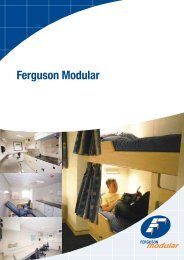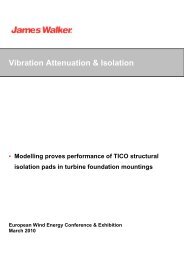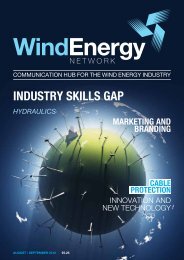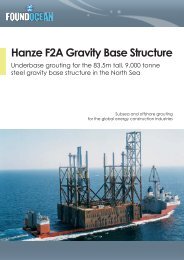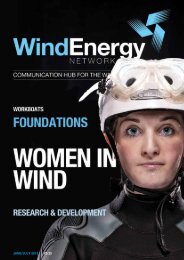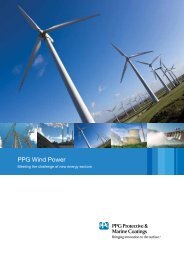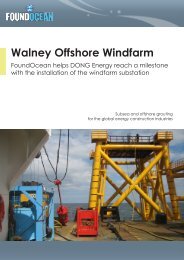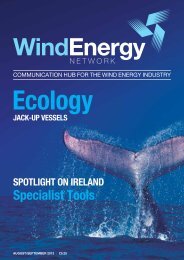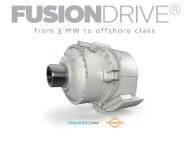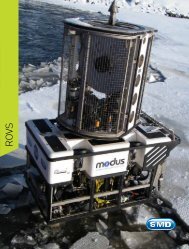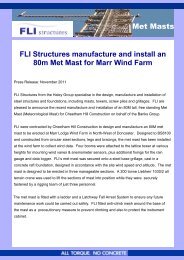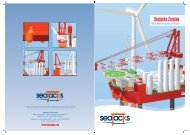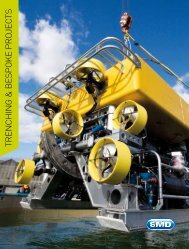WORKING AT HEIGHTS - Wind Energy Network
WORKING AT HEIGHTS - Wind Energy Network
WORKING AT HEIGHTS - Wind Energy Network
Create successful ePaper yourself
Turn your PDF publications into a flip-book with our unique Google optimized e-Paper software.
SPONSORS OF TYNE & TEES FE<strong>AT</strong>UREThinking bigthe challenge for logisticsThe logistical challenges oftransporting or installing outsize andheavy components such as turbinesand blades are considerable, andwith larger units on the horizon thoseinvolved in the renewable energysector require planning and foresight,alongside more Government clarity.UncertaintyThere is great uncertainty in the wind farmsector which many believe is based onlack of demand and no clear directionfrom the UK Government.The uncertainty of manufacturers in therenewable energy market is reflected bycompanies, including those involved inproviding transport and logistics servicesto those manufacturers. The problemis particularly acute because much ofthe equipment and facilities required tohandle, for instance, wind turbines, willneed to be purpose-built.TransportationAbout 90% of the world’s non-bulkcargo is transported in containers, butsubstructures, turbines and blades fallinto the 10% of cargo that is too large orheavy to be shipped in a sea container.And while some transport companies andports are used to handling a wide varietyof ‘heavy and ugly’ freight, it makes nosense for them to invest in facilities forhandling wind farm equipment until theyknow exactly what will be manufactured.Going in blindJerry Hopkinson, Managing Director –bulks, ports and logistics at PD Ports,explains: “We have the ability to developour port assets to cater for a rangeof different scenarios, but, given thediffering requirements of the variousmanufacturers and fabricators, untilwe know exactly the nature and scopeof what will be fabricated and shippedthrough the port, it is difficult to developthe port infrastructure.”Mr Hopkinson further explains, “We needthe developers and the manufacturersto make the decisions, but they are notmaking the orders because they arewaiting on Government commitments onlong-term policies and subsidies.”Time, the greatest hurdleThe problem is made worse by the factthat building vessels and upgrading portand other transport facilities takes time.But time is something the UK Governmentdoes not have. It has signed up to the EURenewable <strong>Energy</strong> Directive, committingit to producing 15% of UK energy fromrenewable resources by 2020. Andfor electricity specifically, the target is30%, with more than two-thirds of thatpredicted to come from onshore andoffshore wind.Round 3 developmentsIn 2010, the Crown Estate announced thesuccessful bidders for Round 3 of the UK’soffshore wind development, in nine furtherzones. These Round 3 developments areenvisaged on a much bigger scale thanRounds 1 and 2 combined.At the moment, there are just 16 offshorewind farms, generating 1,858.20 MWe(compared with 324 onshore wind farms)according to RenewableUK. “Unless theGovernment makes some decisions verysoon, or manufacturers make the bolddecision to build wind turbines withoutany firm orders, our ability to build thefacilities to assist in meeting these targetsis hindered.” says Mr Hopkinson.Hampering potentialPD Ports owns the ports of Teesport andHartlepool and has already designatedHartlepool as the focus for its renewableenergy facilities. The port has deep water,plenty of land available for companies tobuild manufacturing facilities and is alreadyhome to JDR Cable Systems, a leadingcable manufacturer for renewable energyprojects, and HeeremaFabrication Group,which specialises in theengineering and fabricationof large and complexstructures, mainly for theoffshore oil and gas andenergy industry.“We are talking to theindustry all the time butthere are still so manyvariables. We couldconfigure Hartlepool ina particular way to suit aturbine manufacturer, butit would need to be different if it was asub-structure manufacturer – so we can’tprepare in advance.”While some vessels are being built witha view to the Round 3 market, there willpotentially not be enough to meet needsif a sudden upsurge in demand follows aGovernment policy announcement.Unlike electronics, where products getsmaller as technology advances, there isno reason to believe the same is true aswind power technology advances. In fact,the European <strong>Wind</strong> <strong>Energy</strong> Association(EWEA) predicts that as the number ofwind farms grows, the more they will haveto be located in deeper water where thewind speeds are higher – and the larger theturbines will have to be.Huge potentialMr Hopkinson concludes: “Like someother ports, we already have stronglinks with manufacturers in the sectorand have handled a range of productsfor renewable energy customers. Thereis huge potential for ports and othertransport companies to develop at leastpart of their businesses around therenewable energy sector, but we areall hampered by the lack of informationabout what is needed.”PD Portswww.pdports.co.uk26www.windenergynetwork.co.uk



